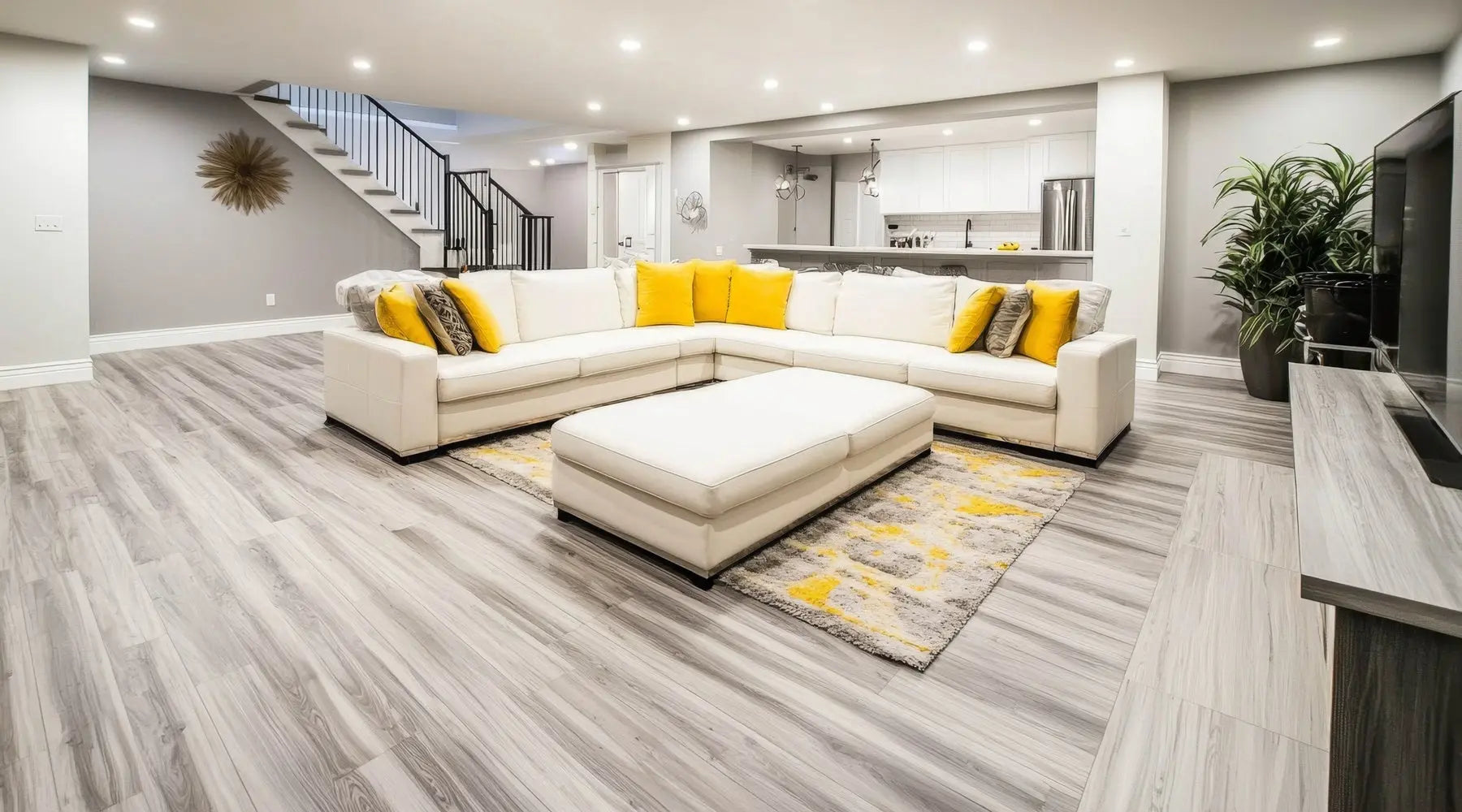Your basement doesn’t have to feel like a dungeon. With the right approach, you can convert that underutilized space into one of the most comfortable areas of your home. Many homeowners overlook their basements, but these spaces offer incredible potential for expansion without the cost of adding square footage to your house.
These essential steps, from controlling moisture and improving lighting to optimizing temperature and creating functional layouts, can make your basement more comfortable.
Control Moisture and Humidity Levels
Moisture control forms the foundation of any comfortable basement. Basements naturally accumulate moisture due to their below-grade location, and this excess humidity can create uncomfortable conditions and potential health hazards.
Start by identifying moisture sources. Check for water seepage through foundation walls, condensation on pipes, or inadequate drainage around your home’s perimeter. Address these issues before making other improvements, as moisture problems will undermine your efforts to create a comfortable space.
Improve Moisture Levels
Installing a quality dehumidifier makes a significant difference in basement comfort. When you notice condensation on windows, musty odors, or visible mold growth, this is a sign that you might need a dehumidifier in your home. Choose a unit sized appropriately for your basement’s square footage, and maintain humidity levels between 30–50 percent for optimal comfort.
Proper ventilation works hand-in-hand with dehumidification. Install exhaust fans in areas prone to moisture, such as near laundry equipment or bathrooms. Ensure your HVAC system includes basement air circulation, or consider adding dedicated ventilation to prevent stagnant air conditions.
Upgrade Your Lighting Strategy
Poor lighting makes basements feel cramped and unwelcoming. Most basements rely on inadequate overhead fixtures that create harsh shadows and dim conditions. A comprehensive lighting plan transforms the space entirely.
Layer your lighting with multiple types and sources. Ambient lighting provides overall illumination, while task lighting focuses on specific activities. Recessed LED lights offer excellent ambient lighting without taking up ceiling space. Plus, you can install them on dimmer switches for flexibility throughout the day. Add table lamps, floor lamps, or wall sconces for task and accent lighting. These portable options allow you to adjust lighting as your space usage changes.
Insulate and Seal for Temperature Control
Temperature regulation challenges many basement conversions. These spaces often feel too cold in winter and too humid in summer. Proper insulation and air sealing create consistent, comfortable temperatures year-round.
Insulate exterior foundation walls to prevent heat loss and reduce condensation. Rigid foam insulation works well for this application, as it resists moisture better than fiberglass. You should also seal air leaks around windows, doors, and utility penetrations. Use caulk for small gaps and expanding foam for larger openings. These seemingly minor leaks significantly impact temperature control and energy efficiency.
Choose Appropriate Flooring Materials
Basement flooring must withstand moisture while providing comfort underfoot. Traditional flooring materials often fail in basement environments, leading to warping, mold, or deterioration. Luxury vinyl plank flooring excels in basement applications since it resists moisture, provides cushioning, and offers realistic wood or stone appearances. Installation over a moisture barrier protects against ground moisture migration.
Polished concrete creates a modern, industrial aesthetic while remaining completely waterproof. Ceramic or porcelain tile also works well for basements, especially in areas prone to moisture. Choose larger format tiles to minimize grout lines, and use appropriate underlayment for comfort and insulation.
Create Functional Zones
Smart space planning maximizes basement utility while maintaining comfort. Define different areas for various activities rather than treating the entire space as one large room.
Entertainment zones work well in basements due to their natural soundproofing qualities. If you want to turn your basement into the ultimate man cave, focus on comfortable seating, proper lighting for screens, and adequate ventilation for gatherings.
Meanwhile, work areas benefit from natural light when available. Position desks or craft tables near basement windows, and supplement with task lighting. Ensure adequate electrical outlets and network connections for modern work requirements.
Soundproof for Privacy and Comfort
Basements offer natural sound isolation, but additional soundproofing enhances comfort for both basement users and occupants of upper floors. Install acoustic panels on the ceiling to reduce sound transmission upward. These panels also improve sound quality within the basement by reducing echo and reverberation.
Also, add carpeting or rugs in areas where footsteps might disturb others. Dense padding under area rugs provides additional sound absorption while improving underfoot comfort.
Address Ceiling Height Concerns
Low ceiling height challenges many basement comfort improvements. Standard residential basements often have seven- to eight-foot ceilings, which can feel cramped compared to main floor spaces.
You can overcome this by painting ceilings and walls in light colors to create visual height. White or very light colors reflect available light and make spaces feel larger. Avoid dark colors that absorb light and create a cave-like feeling.
You can also select furniture proportional to your ceiling height. Lower-profile sofas, tables, and storage units maintain proper visual scale and prevent the space from feeling overcrowded.
Improve Air Quality
Basement air quality directly affects comfort and health. These below-grade spaces often trap pollutants and develop stale air without proper attention to air quality factors. Install air purification systems to remove particulates and odors. HEPA filters capture small particles, while activated carbon filters address chemical odors and volatile organic compounds.
For style and comfort, add houseplants that thrive in lower light conditions. Plants like pothos, snake plants, or peace lilies naturally filter air while adding life to basement spaces.
Plan Your Basement Transformation
Creating a comfortable basement requires systematic planning and execution. Start with essential infrastructure improvements like moisture control and climate management before moving to aesthetic enhancements.
Budget for quality materials and professional installation where appropriate. Basement improvements are long-term investments in your home’s value and your family’s comfort. Cutting corners on critical systems like moisture control or electrical work often leads to expensive problems later.
Your basement transformation project can significantly expand your home’s usable space while creating a comfortable retreat from daily stresses. With proper planning and execution, your basement can become one of your home’s most valued spaces.


Share:
Simple Ways To Make Your Kitchen Seem More Luxurious
American Made Men's Grooming Products